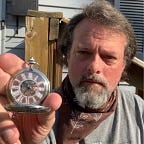Inanimate me
If you have not yet read the first part — while I appreciate your enthusiasm — this would probably make more sense if you started at the beginning. But do what you want; I’m not the boss of you.
“If a pastry plate sitting on the table of a weekend cable news show could talk, what would it say?”
Most things worth doing start with a question. That was the question I asked myself before launching into what could arguably be the most silly, yet oddly rewarding, venture of my media career. With this question rattling around in my head, I found my next adventure.
Off to the twitters!
In September of 2011, MSNBC launched an untested format in cable news — the television version of the long-form essay — aptly named UP with Chris Hayes because it aired from 8–10am ET. A small but loyal group of viewers and fans started watching and quickly adopted the hashtag #uppers. I counted myself among these early adopters.
All winter, every weekend, I watched with the #uppers hashtag trending every weekend. I established the @UpPastryPlate account on twitter, tweeted out I was baking for next weekend and I was a real, live sentient object. We established the hashtag #pastriot and awarded it to guests who were caught by the live, on-air cameras eating from the pastry plate. It became a very big deal within the #uppers community, even becoming a game of cat-and-mouse between the guests and the control room.
That next month, LA Food Weekly came out with an article on Chris Hayes, which mentions the Pastry Plate, they go out and find my twitter handle, publish it and I saw a little over a thousand new followers within the day.
Chris Hayes eventually moved into prime time in 2013 with his show All In with Chris Hayes, in part fueled by the popularity created by a few hundred thousand fans called #uppers who hooked into a conversation and community they found in the Pastry Plate. Steve Kornacki took over the UP host seat and adopted the Plate as a “mascot,” cementing the brand even further.
The account even led to a presentation at SXSW in March of 2015, discussing whether anonymity can be authentic. It can and almost always is.
Eventually, MSNBC cancelled the show at the end of 2015 as talent contracts expired and Andy Lack tried moving the weekend format more toward rolling coverage.
At that point, I moved the @UpPastryPlate into the more generic @PastryPlate account and continued tweeting as a free agent, retaining a large contingent of #uppers and slowly gaining new members.
In October of 2017, while walking my dogs in the park, I received a text from one of the MSNBC producers who knew I was from the Chris and Steve days, asking if I would be interested in supporting a new UP show with the @UpPastryPlate account.
“Heck yeah! When do we start?”
The new UP used the same format, with David Gura — formerly of NPR — as the host. We ran for another 18 months, with the eventual cancel — again — in January of 2019. David’s sign-off acknowledged the contributions of the Pastry Plate which was a big hit with the fans and friends of the show.
In every case, Chris, Steve and David knew my real identity, even as they were sworn to secrecy* from their co-workers and producers. It was a bit of fun, a bit of mystery that went with creating the illusion of a sentient pastry plate. Of course, everybody knew there was a human being behind the account, but staying in character was critical for the illusion to work.
The Plate was much more than a silly foray into the insane world of cable television politics. To have developed the character of a sentient pastry plate over seven+ years, spanning over 240,000 tweets and guiding a community along online as the show broadcast live and not learned anything, would be a waste of time.
- People have a craving to belong to a community, to be heard and seen. The Plate tried hard to be true to that need, replying, liking or RTing as fast as possible during the live show as well as responding between segments on commercial breaks.
- Guests need validation, especially elected officials. More than once, a producer would DM me, saying that the guest asked, “What did the Pastry Plate tweet about me?” Every guest checked their twitter feed either during breaks or immediately after their hit.
- The Plate was personal to many people at home. One #upper in particular would watch UP with her mom during visits at hospice, saying her mom and her enjoyed laughing at the tweets and following along, that she died happy. It continues to awe and humble me, knowing that there was a real person behind every tweet. It shaped the conversation within a human context, not just bits on the screen going into a void.
- Playing the character of an inanimate object on twitter is hard. The first week, you run out of pastry puns and you better have something else to sustain that character. It takes improv and repartee skills in abundance. Knowing lots of trivia also helps; not Ken Jennings stuff, but pretty darn close. Fortunately, I had more than ten years prior, playing a dog on the internet @dogwalkblog
Now that Up on MSNBC has been retired, (for now) I continue to play the part of the Pastry Plate, interested in the intersection of pastry, politics and pop culture.
This story is being told here is small bits for manufactured drama.
Book | Part One | Part Two | Part Three | Part Four | Part Five | Part Six
*And now you know. Use this knowledge wisely. Also, Currant Events
